The iPad Air Review
by Anand Lal Shimpi on October 29, 2013 9:00 PM ESTiPhone to iPad: CPU Changes
Although the iPad Air uses the same A7 from the iPhone 5s (and M7 motion coprocessor), there are a few minor differences that do lead to better performance.
At a high level we’re still talking about two 64-bit Apple Cyclone cores with 128KB L1s (64KB I$ + 64KB D$) per core, a shared 1MB L2 cache and a 4MB L3 cache that services the entire SoC. Apple increased CPU frequency from 1.3GHz to 1.4GHz in the iPad Air, a mild increase but in line with what we’ve seen from previous iPad designs. That’s the first impact on performance - a 7.69% increase in CPU frequency.
The second impact on performance is something I only noticed while digging around under the hood of the A7. It seems like the implementation in the iPad Air can, for whatever reason, hold more instructions in flight (over 20% more) than the A7 in the iPhone 5s. It’s unclear to me whether the A7 in the iPad is configured any differently via firmware/microcode or if perhaps we’re looking at a slightly different revision of the core, but the delta was repeatable in my testing.
The third, and likely biggest change impacting the iPad Air’s implementation of the A7 is the additional thermal headroom afforded by the larger chassis. I’m not going to go into details on exactly what this next test does (unfortunately we’re going to occlude some of the low level work that we do in light of all of the benchmark cheating going on), but we’re looking at a curve of performance vs. time for a particularly power heavy mix of code. We’re running the same exact code on both the iPad Air and iPhone 5s here, the only real difference is the size of the chassis:
You can see the 5s throttles back its CPU frequency to about 1GHz after the 2 minute mark. The crazy thing is that until that point the 5s manages to run at full frequency without so much as a hiccup for two full minutes, running an incredibly power hungry task. Given that most iOS apps aren’t this power intensive for such a sustained period of time, iPhone 5s users should almost always see the A7 running at a full 1.3GHz. Pretty crazy.
The iPad Air by comparison shows much more controlled behavior. Early on in the test we see a 7.7% performance advantage, which lines up perfectly with the iPad Air’s 7.7% CPU frequency advantage. By the end of the test the iPhone 5s has throttled to 900MHz, while the iPad Air drops to around 1.2GHz. At this point the iPad Air’s performance advantage grows to almost 40%.
CPU Performance
I've gone through our standard set of cross-platform browser based benchmarks to place the iPad Air's performance in perspective. As I mentioned in our 5s review, I don't know that there are many (any?) applications on iOS 7 that can really take advantage of all the A7 has to offer. There's definitely a ton of headroom left in the design. What's particularly exciting is when the A7 ends up in n-1 or n-2 iOS devices and it becomes the minimum developer target going forward.
I won't go through all of the results here again, but it's safe to say that the iPad Air is the fastest ARM based tablet on the planet at this point.
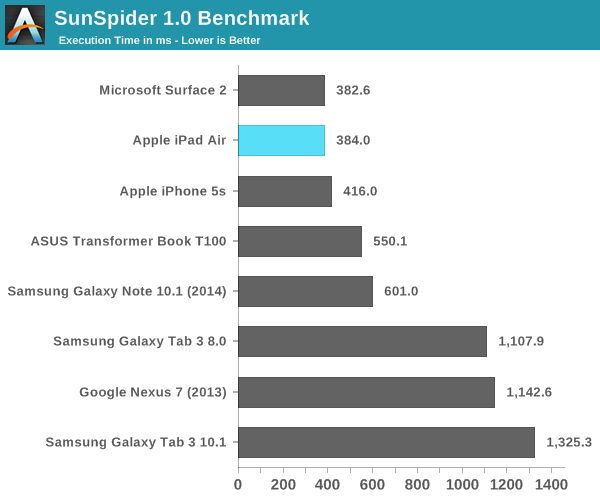
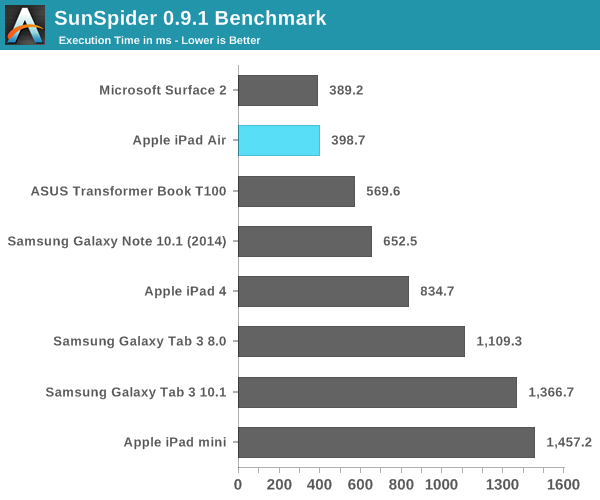
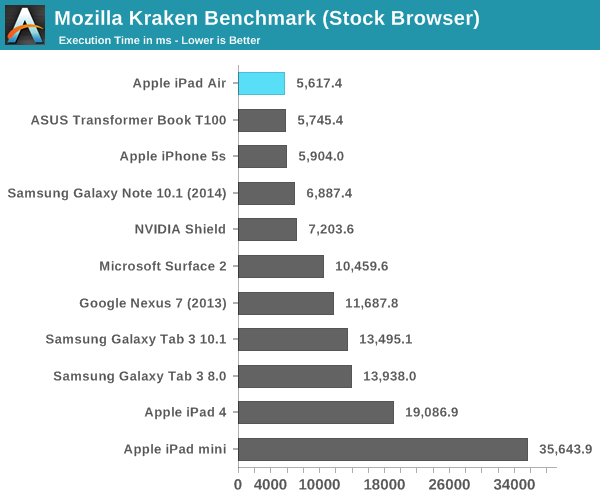
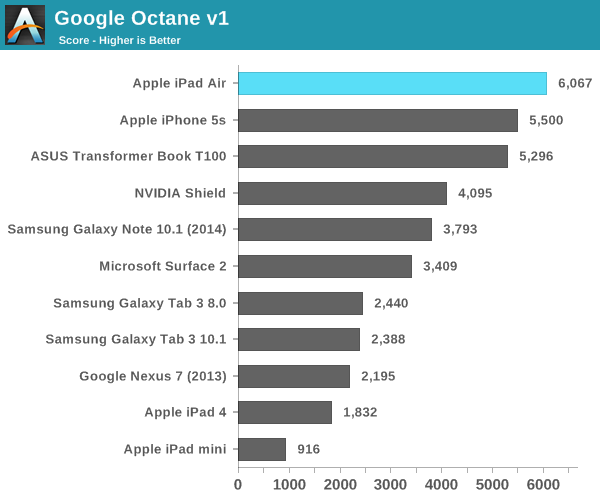
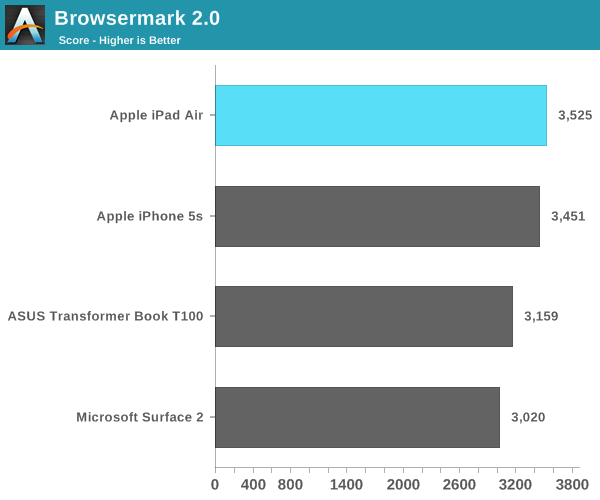

A7 Power Consumption
I’ll get to battery life in a bit, but I’ve been curious about the dynamic range of power consumption offered by Apple’s new A7 SoC. On the one hand we’re dealing with a lower power process (28nm vs. 32nm), but on the other hand Apple’s Cyclone cores can clearly draw more power given how beefy the architecture is this round. Apple frowns upon review sample dissection so I had to turn to a less scientific method of external platform level power measurement. The fidelity of the numbers here aren’t all that great but it’s better than nothing.
For the first test I measured platform power consumption during a Kraken run:
I purposely started measuring before the benchmark so I could get an idea of idle power consumption. The iPad Air consumes roughly 72% of the idle power as the iPad 4, both running at the same brightness. Here we’re not just seeing the A7’s advantages but also things like lower display power.
Focusing on the load portion of the measurement we see that both the new iPad and old iPad consume the same total power in this test. I suspect the A7 is drawing more power than the A6X, but it’s masked by a lower power display. Given how much faster the iPad Air is, Apple’s latest tablet features far lower overall task energy than the outgoing iPad 4. This is probably both the best case scenario for the iPad Air and the most likely case as well.
For kicks I wanted to see just how much power I could get the iPad Air to draw. Here I’m looking at platform power during our mini-power-virus test from above:
How’s that for dynamic range? Almost 12W running all out, but around half that in what we’d normally consider to be a stressful CPU test. I couldn’t get any actual applications/games on the iPad Air to behave like this so the results above are purely academic (for now). A quick run through GFXBench 2.7’s T-Rex HD test confirms that even pushing the GPU won’t hit these numbers. The max I saw running T-Rex offscreen was ~6W, and turning to an actual game (Infinity Blade 3) the iPad Air pulls less than 5W.


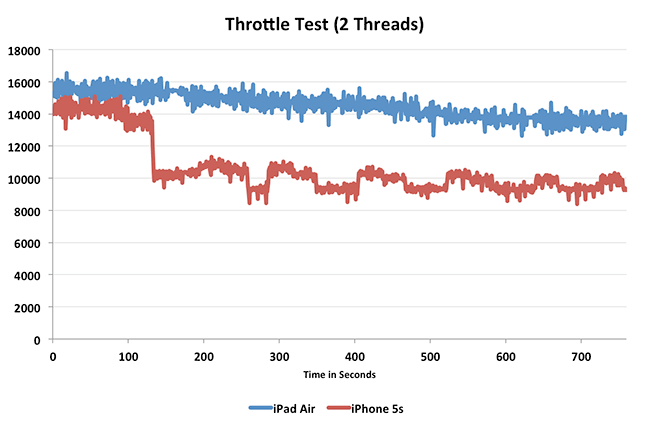
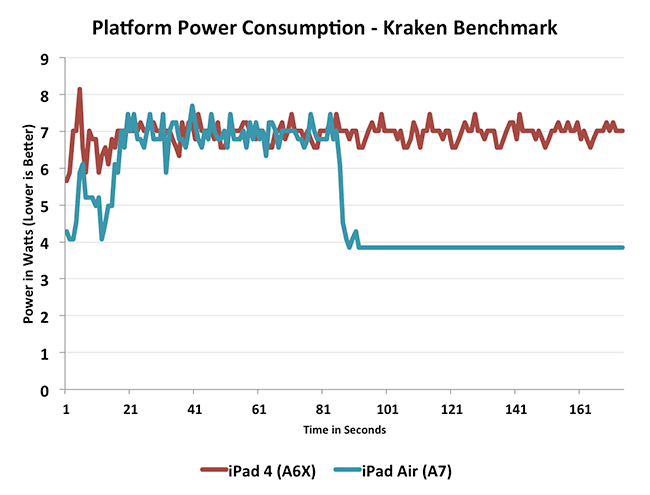
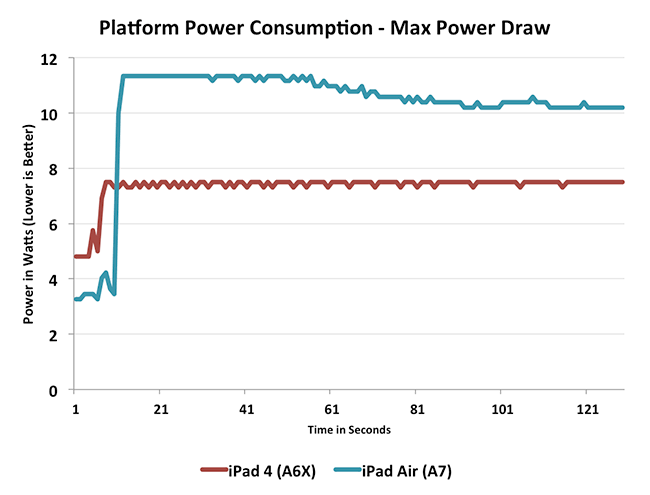








444 Comments
View All Comments
StigtriX - Tuesday, November 12, 2013 - link
Actually, the new Kindle 8.9 has at least as good a display as the iPad Air, if not better:"Amazon’s always touted the displays on its tablets, and the screen it’s using on the HDX 8.9 is a doozy. At a ridiculous 2560 x 1600-pixel resolution and 339ppi, it’s either higher-resolution or more pixel-dense than virtually any other tablet on the market. It also has great viewing angles, excellent color reproduction, and high brightness levels. It’s really just a great screen, whether you’re gaming, watching video, or reading text — it’s right up there with, if not better than, the Retina display on the iPad Air."
- The Verge
"While the speakers feel like something of an afterthought, Amazon is clearly waging a battle on the display front. The company keeps upping its game, and indeed, the screen here dazzles, with 2,560 x 1,600 resolution and a pixel density of 339 pixels per inch. That's a big jump up from the HD 8.9's 1,920 x 1,200 display, not to mention the new HDX 7-inch tablet, which has a 1,920 x 1,200 screen. It's even enough to make the iPad Air's 2,048 x 1,536 resolution (264 ppi) seem modest. It's simply a gorgeous thing to behold, making movie watching a downright pleasure. Heck, it even managed to make Sharknado look pretty good, which is no small feat. All in all, images are sharp, the level of detail is impressive and the colors are vibrant."
- Engadget
But, I do agree with you that too many let their personal opinions colour their reading of reviews. I prefer Android and PC, but I have an iPad and have tried several Macs. Even though I prefer other units, there is no point in denying the excellent quality and style Apple products come with. They, like Nintendo, only release products "when they are done" - no rushing.
MassiveTurboLag - Tuesday, October 29, 2013 - link
Really? You clearly never looked over one of their Android phone reviews. They are stupidly detailed.dsumanik - Wednesday, October 30, 2013 - link
Read this review with a grain of salt. Anand lai shimpi is heavenly vested in apple stock, doing everything he can to boost the dismal situation.Thinner bezels and light weight do not hide the fact that functionally, this iPad is the same as the previous 2 generations.
Sent from my ipad3, which will be upgraded when apple actually updates the product line.
Here's some basic ideas mr cook:
Wireless charging
Fingerprint scanner
Thunderbolt sync or usb3
Haptic feedback
NFC
Solon - Wednesday, October 30, 2013 - link
Wireless charging - deeply inefficient charging; maybe 50% of energy is actually picked up by the deviceFingerprint scanner - probably getting one next gen
Thunderbolt sync or USB3 - maybe; and it is possible the hardware already can do this; but Thunderbolt (a PCI-E spec) will never happen
Haptic feedback - dead concept; no one actually wants this; RIM failed at haptic
NFS - in a tablet? and is NFC actually used? No, it isn't.
dishayu - Wednesday, October 30, 2013 - link
Agree with your wireless charging argument, but that limits you from charging your iDevice if you don't have your own cable. All android phones use microusb, so it's not hard to find one at all (speaking of the real world here). Apple chose not to afford themselves that luxury.Fingerprint scanner : Although I think it's a gimmick and useless for the masses (almost everyone except from corporate users), they could have done it now, since they already have it in 5s. Why wait till next gen?
Haptic feedback : You probably would have said the same about touchscreens around 2005. I tried staying away from smartphones altogether until the Xperia Pro because there were no decent phone with a proper keyboard. After that I finally gave in an bought the HTC One and I still really miss my physical buttons. Haptic feedback could cure that.
NFC : I use it as much as I use Bluetooth (which is to say not a whole lot but a very handy feature still and I'd like to have it)
ws3 - Tuesday, October 29, 2013 - link
Yeah. Anyone who wanted to be truly objective would stopping running all of those tests that the iPad Air does so well in. If you want to be truly balanced, you have to run a bunch of tests that the iPad sucks at too, like maybe an .apk loading test or a malware running test.zeagus - Wednesday, October 30, 2013 - link
+lulzKoolAidMan1 - Wednesday, October 30, 2013 - link
Perfectpdjblum - Thursday, October 31, 2013 - link
Anand himself has stated where his loyalties lie: He said during a podcast that his advertisers were the motivating force behind the change in the look of the website. Obviously he is a slave to his advertisers who obviously want as much crApple content on the site as possible; of course they want it be overwhelmingly positive. This crApple model generates tons of hits for theverge and it does the same for anandtech.markthema3 - Monday, November 4, 2013 - link
He changed the layout of the site to better place the advertisments on the page. That's not catering to an individual company. The conclusion that he is therefore a slave to the advertisers is unfounded.